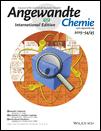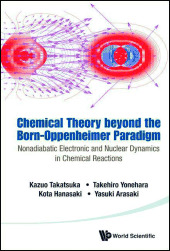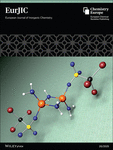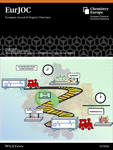Journal list menu
Export Citations
Download PDFs
Cover Pictures
Cover Picture: Uranium from German Nuclear Power Projects of the 1940s— A Nuclear Forensic Investigation (Angew. Chem. Int. Ed. 45/2015)
- Page: 13137
- First Published: 22 September 2015

Nuclear forensics was used to trace the history of two pieces of uranium metal, which are purported to originate from the first German nuclear reaction experiments in the 1940s. In their Communication on page 13452 ff., M. Wallenius et al. compared the macroscopic sample properties with literature information and determined the production date and source of the uranium samples.
Inside Cover: Squaramide-Catalyzed Synthesis of Enantioenriched Spirocyclic Oxindoles via Ketimine Intermediates with Multiple Active Sites (Angew. Chem. Int. Ed. 45/2015)
- Page: 13138
- First Published: 21 September 2015

Enantioenriched five-membered spirocyclic oxindoles were successfully assembled through an organocatalytic cascade reaction as described by X.-W. Sun and co-workers in their Communication on page 13253 ff. The formation of the ketimine intermediate and the ensuing Michael–Mannich reaction were catalyzed by a bifunctional quinine-derived squaramide. Complex architectures with adjacent quaternary carbon centers were thus efficiently constructed from readily available starting materials.
Inside Back Cover: Biocatalytic Feedback-Driven Temporal Programming of Self-Regulating Peptide Hydrogels (Angew. Chem. Int. Ed. 45/2015)
- Page: 13467
- First Published: 17 September 2015

The autonomous self-regulation of a pH-responsive peptide hydrogelator by internal biocatalytic feedback is reported by A. Walther and co-workers in their Communication on page 13258 ff. The resulting dynamic hydrogels have a programmed lifetime and are suitable for applications in transient rapid prototyping and fluidic guidance.
Back Cover: Locating Gases in Porous Materials: Cryogenic Loading of Fuel-Related Gases Into a Sc-based Metal–Organic Framework under Extreme Pressures (Angew. Chem. Int. Ed. 45/2015)
- Page: 13468
- First Published: 22 September 2015

A cryogenic technique for loading a porous metal–organic framework with gas molecules is described by S. A. Moggach et al. in their Communication on page 13332 ff. The technique, usually used by physicists and planetary scientists, involves loading gases cryogenically into a diamond anvil cell. Here, both CO2 and CH4 were loaded into a scandium-based MOF. On increasing pressure the presence of a previously unobserved adsorption site was elucidated, and the pores were “superfilled” with guest molecules at room temperature.
Frontispiece
Frontispiece: Sugar–Protein Connectivity Impacts on the Immunogenicity of Site-Selective Salmonella O-Antigen Glycoconjugate Vaccines
- First Published: 26 October 2015

Glycoproteins In their Communication on page 13198 ff., Q.-Y. Hu, F. Micoli et al. present two methods for the preparation of glycoconjugate vaccines with one single sugar chain linked to one or two positions of a carrier protein.
Graphical Abstract
Graphical Abstract: Angew. Chem. Int. Ed. 45/2015
- Pages: 13141-13157
- First Published: 26 October 2015
News
Spotlights on our sister journals: Angew. Chem. Int. Ed. 45/2015
- Pages: 13158-13161
- First Published: 26 October 2015
Author Profile
News
Book Review
Chemical Theory beyond the Born–Oppenheimer Paradigm. Nonadiabatic Electronic and Nuclear Dynamics in Chemical Reactions. By Kazuo Takatsuka, Takehiro Yonehara, Kota Hanasaki, and Yasuki Arasaki.
- Page: 13164
- First Published: 25 September 2015
Highlight
GPCRs
Arrestin-Bound Rhodopsin: A Molecular Structure and its Impact on the Development of Biased GPCR Ligands
- Pages: 13166-13168
- First Published: 11 September 2015
Minireview
Synthetic Methods
Cyanoalkylation: Alkylnitriles in Catalytic CC Bond-Forming Reactions
- Pages: 13170-13184
- First Published: 21 September 2015

On the playlist: This review provides an overview on the catalytic activation modes employed to overcome the attenuated reactivity of alkylnitriles as carbon pronucleophiles in catalytic carbon–carbon bond-forming reactions. The lack of catalytic asymmetric procedures clearly poses a challenge and offers a great opportunity for future improvements in this emerging area of research.
Review
Renewable Feedstock
Renewable Feedstocks: The Problem of Catalyst Deactivation and its Mitigation
- Pages: 13186-13197
- First Published: 12 October 2015

Rising to the challenge: This Review focuses on the main challenges concerning the long-term stability of catalysts for the conversion of bio-based feedstock into fuels and chemicals. Methods have been proposed to achieve this goal. Three main challenges need to be overcome to solve the problem of catalyst deactivation: catalyst fouling, catalyst poisoning, and catalyst destruction.
Communications
Glycoproteins | Hot Paper
Sugar–Protein Connectivity Impacts on the Immunogenicity of Site-Selective Salmonella O-Antigen Glycoconjugate Vaccines
- Pages: 13198-13203
- First Published: 09 September 2015

A vaccine against salmonella: Two methods are reported for the preparation of site-selective glycoconjugate vaccines with one single sugar chain linked to one or two precise positions of the CRM197 carrier protein (see picture; OAg=O-Antigen). The point of linkage on the protein plays a role in determining the immunogenicity of the glycoconjugate vaccines in mice.
Foldamers
A Hollow Foldecture with Truncated Trigonal Bipyramid Shape from the Self-Assembly of an 11-Helical Foldamer
- Pages: 13204-13207
- First Published: 27 August 2015
Antibiotic Switches
A Supramolecular Antibiotic Switch for Antibacterial Regulation
- Pages: 13208-13213
- First Published: 26 August 2015

A supramolecular antibiotic switch to reversibly “turn-on” and “turn-off” antibacterial activity on demand was developed as a proof-of-concept to regulate antibacterial activity. The switch relies on the supramolecular assembly and disassembly of a poly(phenylene vinylene) derivative (PPV) with cucurbit[7]uril (CB[7]). This strategy does not require any chemical modification on the active sites of the antibacterial agent.
Biosensors
A Modular, DNA-Based Beacon for Single-Step Fluorescence Detection of Antibodies and Other Proteins
- Pages: 13214-13218
- First Published: 04 September 2015

A versatile system for the one-step fluorescence detection of proteins is based on a conformation-switching stem–loop DNA scaffold that presents a recognition element on each of its two stem strands. The steric strain associated with the binding of target molecules opens the stem, thus enhancing the emission of an attached fluorophore/quencher pair.
Combinatorial Chemistry
A General Synthetic Approach for Designing Epitope Targeted Macrocyclic Peptide Ligands
- Pages: 13219-13224
- First Published: 17 September 2015

Match made in situ: 12 peptide ligands against distinct epitopes of challenging proteins were developed using a general strategy. A synthetic epitope with an azide was screened against an alkyne-containing macrocyclic library to identify the best binder. These macrocyclic ligands can enable antibody-like therapeutic and diagnostic applications, with small molecular footprints.
Electrical Energy Storage
Cation-Dependent Stabilization of Electrogenerated Naphthalene Diimide Dianions in Porous Polymer Thin Films and Their Application to Electrical Energy Storage
- Pages: 13225-13229
- First Published: 10 September 2015

Charge me up: Thin films of a naphthalene diimide porous polymer exhibit 20 % greater energy density in the presence of counter cations that stabilize their reduced forms in the solid-state. Such behaviour is not observed for the monomer in solution, pointing to the importance of polymer structure in electrical energy storage devices.
Single-Molecule Microscopy
Multicolor Caged dSTORM Resolves the Ultrastructure of Synaptic Vesicles in the Brain
- Pages: 13230-13235
- First Published: 08 September 2015

dSTORM gets colorful: A screen for fluorescence recovery following reduction revealed several dyes suitable for high-resolution caged dSTORM imaging. Using dye pairs, multicolor localization precision could be achieved below 15 nm. This system is used to resolve the ultrastructure of single synaptic vesicles. Scale bar: 20 nm.
Carbenes
Difluorocarbene-Derived Trifluoromethylthiolation and [18F]Trifluoromethylthiolation of Aliphatic Electrophiles
- Pages: 13236-13240
- First Published: 21 September 2015
![Difluorocarbene-Derived Trifluoromethylthiolation and [18F]Trifluoromethylthiolation of Aliphatic Electrophiles](/cms/asset/d261b229-f2e5-43f8-a3b0-71472ac64abd/mcontent.jpg)
[18F] label: An efficient, fast, and transition-metal-free protocol for trifluoromethylthiolation of alkyl electrophiles with in situ generated difluorocarbene in the presence of elemental sulfur and external fluoride ions is described. This strategy was applied to [18F]trifluoromethylthiolation of alkyl electrophiles, which represents the first example of this type. Ts=4-toluenesulfonyl.
Organic Cages
Porphyrin Boxes: Rationally Designed Porous Organic Cages
- Pages: 13241-13244
- First Published: 25 August 2015
Biosensors | Hot Paper
Electronic Olfactory Sensor Based on A. mellifera Odorant-Binding Protein 14 on a Reduced Graphene Oxide Field-Effect Transistor
- Pages: 13245-13248
- First Published: 14 September 2015

Smell checker: Olfaction of the honey bee was mimicked by a graphene-based biosensor. Electrical measurements monitored the binding of honey-bee-attracting odorants to the immobilized receptor odorant-binding protein 14 (OBP14). The sensor is able to discriminate between odorants in real time in a quantitative manner, yielding full reaction kinetics of ligand–receptor interactions, and revealed the importance of a hydroxy substituent for the recognition of aromatic odorants.
Nitrogenases
The Fe–V Cofactor of Vanadium Nitrogenase Contains an Interstitial Carbon Atom
- Pages: 13249-13252
- First Published: 17 September 2015

Stuck in the middle: The first experimental evidence for the presence of an interstitial carbide in the active-site FeV cofactor in vanadium nitrogenase is presented. The presence of the carbide was identified using valence-to-core X-ray emission spectroscopy. The carbide is analogous to that of the FeMo cofactor of molybdenum nitrogenase, and is only the second reported carbide ligand in biology.
Organocatalysis
Squaramide-Catalyzed Synthesis of Enantioenriched Spirocyclic Oxindoles via Ketimine Intermediates with Multiple Active Sites
- Pages: 13253-13257
- First Published: 04 September 2015

Five-membered spirocyclic oxindoles are generated in excellent yields (up to 94 %) and stereoselectivities (up to >20:1 d.r., >99 % ee) in a Michael–Mannich reaction of a ketimine intermediate that is catalyzed by a bifunctional quinine-derived squaramide. A scaled-up variant of this transformation also proceeded smoothly, highlighting the potential of this cascade process.
Programmable Materials
Biocatalytic Feedback-Driven Temporal Programming of Self-Regulating Peptide Hydrogels
- Pages: 13258-13262
- First Published: 06 August 2015

Programmed to self-destruct: An internal enzymatic feedback system enables the autonomous self-regulation over time of a pH-responsive peptide gelator (see picture; SA=self-assembly). The resulting dynamic hydrogels with programmed lifetimes are suitable for application in fluidic guidance, burst release, and transient rapid prototyping.
CO Oxidation
Low-Temperature CO Oxidation over a Ternary Oxide Catalyst with High Resistance to Hydrocarbon Inhibition
- Pages: 13263-13267
- First Published: 11 September 2015

Cheaper and better: Platinum group metal (PGM) catalysts struggle with CO oxidation at low temperatures (<200 °C) due to inhibition by hydrocarbons in exhaust streams. A ternary oxide composed of copper oxide, cobalt oxide, and ceria (CCC) is presented that outperforms commercial PGM catalysts for CO oxidation in simulated automotive exhaust streams while showing no signs of inhibition by propene.
Proline Isomerization
Structural Properties and Stereochemically Distinct Folding Preferences of 4,5-cis and trans-Methano-L-Proline Oligomers: The Shortest Crystalline PPII-Type Helical Proline-Derived Tetramer
- Pages: 13268-13272
- First Published: 08 September 2015

A crystalline PPII-type helical tetramer formed of cis-4,5-methano-L-proline is presented. X-ray diffraction and circular dichroism together with theoretical results highlight the differential behavior of cis- and trans-4,5-methano-L-proline oligomers. These proline methanologues could be incorporated in drugs and peptides as proline mimics with structurally tweaked properties.
Hierarchical Porous Materials | Hot Paper
Hydrolytic Transformation of Microporous Metal–Organic Frameworks to Hierarchical Micro- and Mesoporous MOFs
- Pages: 13273-13278
- First Published: 18 September 2015
Sulfa Drugs
Bacterial Synthesis of Unusual Sulfonamide and Sulfone Antibiotics by Flavoenzyme-Mediated Sulfur Dioxide Capture
- Pages: 13279-13283
- First Published: 14 September 2015

Ménage à trois: A radical-based, three-component reaction of xiamycin and sulfur dioxide leads to the biosynthesis of various bacterial sulfonamide and diarylsulfone antibiotics. Gene deletion, complementation, and biotransformation experiments unequivocally showed the involvement of the flavoprotein XiaH in the biosynthesis of these unprecedented sulfa compounds.
Model Membranes
Chemically Locked Bicelles with High Thermal and Kinetic Stability
- Pages: 13284-13288
- First Published: 16 September 2015

Link and lock: In situ polymerization of a bicellar mixture composed of a phospholipid and polymerizable surfactants afforded unprecedented stable bicelles. The polymerized composite showed an aligned phase over a wide thermal range with excellent 2H quadrupole splitting of the solvent signal, thus suggesting utility as an alignment medium for NMR studies. The crosslinking also notably improved the kinetic stability and alignment morphology of the bicelles.
Conformation Analysis
Magnetic Control of Macromolecular Conformations in Supramolecular Anionic Polysaccharide–Iron Complexes
- Pages: 13289-13292
- First Published: 18 September 2015

Enrichment of iota carrageenan polysaccharides with Fe2+ or Fe3+ induces a conformational transition from random coils to single helices. The noninvasive magnetic manipulation of individual iota–FeII macromolecular conformations is demonstrated by a magnetically induced stiffening and stretching of the helical chains. Multichain clusters arising from the efficient chelation of Fe3+ may serve for iron food fortification purposes.
Fluorescence Probes | Very Important Paper
A Fluorescent Molecular Probe for the Detection of Hydrogen Based on Oxidative Addition Reactions with Crabtree-Type Hydrogenation Catalysts
- Pages: 13293-13296
- First Published: 11 September 2015
Metal–Organic Frameworks
A Robust Infinite Zirconium Phenolate Building Unit to Enhance the Chemical Stability of Zr MOFs
- Pages: 13297-13301
- First Published: 12 October 2015

Water-proof MOF: The reaction of ZrIV with 1,2,3-trioxobenzene moieties leads to the formation of a robust chain-like coordination motif. Such a motif is used to rationally build a new metal–organic framework (MOF) which combines a good water sorption capacity with high chemical stability in physiologically relevant conditions, outperforming archetypical ZrIV carboxylate MOFs.
One-Pot Synthesis | Very Important Paper
Gold Nanoparticles Supported on a Layered Double Hydroxide as Efficient Catalysts for the One-Pot Synthesis of Flavones
- Pages: 13302-13306
- First Published: 14 September 2015

Go for gold: In the presence of gold nanoparticles supported on a Mg-Al layered double hydroxide (Au/LDH), various flavones were obtained from the corresponding 2′-hydroxyacetophenones and benzaldehydes (or benzyl alcohols). All three (four) steps of this one-pot process are catalyzed by Au/LDH in a truly heterogeneous fashion.
Prodrug Design
Enzyme-Instructed Intracellular Molecular Self-Assembly to Boost Activity of Cisplatin against Drug-Resistant Ovarian Cancer Cells
- Pages: 13307-13311
- First Published: 14 September 2015

Cisplatin-boosting nanofibers: The design and synthesis is reported of small peptide precursors that can be cleaved by carboxylesterase (CES) to form peptides that self-assemble in water to form molecular nanofibers. The precursors themselves are innocuous to cells at optimal concentrations, but they double or triple the activity of cisplatin against drug-resistant ovarian cancer cells.
Core–Shell Nanostructures | Very Important Paper
Energy Migration Upconversion in Manganese(II)-Doped Nanoparticles
- Pages: 13312-13317
- First Published: 11 September 2015

On the up: The upconversion emission of Mn2+ ions can be realized in NaGdF4:Yb/Tm@NaGdF4:Mn core–shell nanoparticles by utilizing energy migration through the gadolinium sublattice (see figure). The multiphoton upconversion process can be further enhanced under pulsed laser excitation at high power densities. The ability of the Mn2+-doped nanoparticles to easily undergo oxidization makes them attractive for use in hydrogen peroxide detection.
Phosphorus Heterocycles
Facile Synthesis and Properties of 2-λ5-Phosphaquinolines and 2-λ5-Phosphaquinolin-2-ones
- Pages: 13318-13322
- First Published: 11 September 2015

PN on the scene: A simple route to the little explored phosphaquinoline scaffold is described. These heterocycles form strong homodimers in solution and the solid state, possess large Stokes shifts and high quantum yields at a range of emission wavelengths, and open the way to exploration of the delocalization within cycles containing NPV bonds.
Noncanonical Metallo-Base Pairs
High-Resolution Crystal Structure of a Silver(I)–RNA Hybrid Duplex Containing Watson–Crick-like CSilver(I)C Metallo-Base Pairs
- Pages: 13323-13326
- First Published: 08 October 2015

The high-resolution structures of CAgIC base pairs in A-form RNA duplexes have been solved. Structural information on the present metallo-base pair together with the previously reported THgIIT base pair widely open the possibility of structure-based design of nucleic-acid-based nanodevices containing the natural metallo-base pairs.
Nanowire Synthesis
Silica Nanowires Templated by Amyloid-like Fibrils
- Pages: 13327-13331
- First Published: 05 October 2015
High-Pressure MOF Phases
Locating Gases in Porous Materials: Cryogenic Loading of Fuel-Related Gases Into a Sc-based Metal–Organic Framework under Extreme Pressures
- Pages: 13332-13336
- First Published: 11 September 2015

The maximum gas uptake of porous MOFs was explored by using gases as pressure-transmitting media in high-pressure single-crystal diffraction experiments. A study with supercritical CH4 at 3–25 kbar demonstrates that two high-pressure phase transitions are induced as the filled MOF adapts to reduce the volume of the system.
CH Bond Activation
Rhodium(III)-Catalyzed Allylic C(sp3)–H Activation of Alkenyl Sulfonamides: Unexpected Formation of Azabicycles
- Pages: 13337-13340
- First Published: 11 September 2015

An unusual Rh-catalyzed CH bond activation: Allylic CH bond activation by a RhIII catalyst precedes alkyne insertion leading to an unexpected azabicycle structure in good yield and excellent diastereoselectivity. The mechanism of the reaction was interrogated with deuterium-labeling experiments and is proposed to involve a 1,3-Rh shift followed by an electrocyclization event.
Oxidizing Agents
Hydrogen Peroxide and Di(hydroperoxy)propane Adducts of Phosphine Oxides as Stoichiometric and Soluble Oxidizing Agents
- Pages: 13341-13345
- First Published: 12 October 2015

Hydrogen peroxide rocks! Di(hydroperoxy)propane adducts of phosphine oxides, [R3PO(HOO)2CMe2] (R=alkyl, aryl), are obtained as very large single crystals. Despite their oxidative power, the long-term stability of the compounds is high and they are very soluble in organic solvents. These compounds are therefore ideal oxidizing agents that can be applied stoichiometrically in nonaqueous media.
Heterogeneous Catalysis
Highly Dispersed SiOx/Al2O3 Catalysts Illuminate the Reactivity of Isolated Silanol Sites
- Pages: 13346-13351
- First Published: 23 September 2015

Strong enough to get the job done: By selectively installing isolated (-AlO)3SiOH species on a γ-Al2O3 substrate, a unique “mild” Brønsted-acid catalytic site is formed. These well-defined sites evince highly uniform characteristics and are catalytically competent in the dehydration of cychohexanol, showing higher activity, no loss of selectivity, and no coking.
Cross-Coupling
Comparison of dppf-Supported Nickel Precatalysts for the Suzuki–Miyaura Reaction: The Observation and Activity of Nickel(I)
- Pages: 13352-13356
- First Published: 11 September 2015

I and only I: A series of Ni0, NiI and NiII complexes supported by a bidentate phosphine ligand were prepared. They are all active precatalysts for the Suzuki–Miyaura reaction, and generate an active NiI complex during catalysis. This observation led to the discovery of a bench-stable NiII compound, which can couple heterocylic substrates at room temperature.
Heterocycle Synthesis
Catalytic Cyclization of o-Alkynyl Phenethylamines via Osmacyclopropene Intermediates: Direct Access to Dopaminergic 3-Benzazepines
- Pages: 13357-13361
- First Published: 14 September 2015

Capital catalysts: The osmium-catalyzed cyclization of o-alkynyl phenethylamines enabled the straightforward preparation of a broad range of dopaminergic 3-benzazepine derivatives. More commonly used metal catalysts did not promote the desired reaction efficiently. Mechanistic investigations revealed that the process takes place via osmacyclopropene intermediates, examples of which were isolated and characterized by X-ray diffraction analysis.
BN Coupling | Hot Paper
Alkaline-Earth-Catalyzed Dehydrocoupling of Amines and Boranes
- Pages: 13362-13365
- First Published: 11 September 2015

BoNd-forming catalysis: Dehydrocoupling reactions between the boranes HBpin and 9-borabicyclo[3.3.1]nonane, and a range of amines and anilines ensue under very mild reaction conditions in the presence of a simple β-diketiminato magnesium n-butyl precatalyst. The reaction is facilitated by the Lewis acidity of the borane substrate, and is dictated by resultant pre-equilibria between magnesium hydride and borohydride.
18F Fluorination
Organomediated Enantioselective 18F Fluorination for PET Applications
- Pages: 13366-13369
- First Published: 11 September 2015

PET molecules: A metal-free asymmetric 18F-labeling reaction for an aliphatic CH bond, employing a chiral imidazolidinone as the organomediator and N-[18F]fluorobenzenesulfonimide ([18F]NFSI) as the 18F source, is reported. The method is used to prepare the 18F-labeled positron emission tomography (PET) radiotracer (2S,4S)-4-[18F]fluoroglutamic acid.
Click Chemistry
SuFEx on the Surface: A Flexible Platform for Postpolymerization Modification of Polymer Brushes
- Pages: 13370-13373
- First Published: 09 September 2015
Natural Products
Asperchalasine A, a Cytochalasan Dimer with an Unprecedented Decacyclic Ring System, from Aspergillus flavipes
- Pages: 13374-13378
- First Published: 03 September 2015

A complicated ring system: Asperchalasine A, the first cytochalasan dimer to possess a complex decacyclic 5/6/11/5/5/6/5/11/6/5 ring system, was isolated from Aspergillus flavipes, along with four biogenetic related intermediates, asperchalasines B–D. Asperchalasine A induced significant G1-phase cell cycle arrest in cancerous but not normal cells, highlighting it as a potentially selective cell cycle regulator against cancer cells.
In Vivo Imaging
Enzymatically Shifting Nitroxides for EPR Spectroscopy and Overhauser-Enhanced Magnetic Resonance Imaging
- Pages: 13379-13384
- First Published: 17 September 2015
Hydrogen Production
Stable Co-Catalyst-Free Photocatalytic H2 Evolution From Oxidized Titanium Nitride Nanopowders
- Pages: 13385-13389
- First Published: 02 October 2015
Asymmetric Catalysis
Development of Enantioselective Palladium-Catalyzed Alkene Carboalkoxylation Reactions for the Synthesis of Tetrahydrofurans
- Pages: 13390-13392
- First Published: 14 September 2015

The construction of enantiomerically enriched tetrahydrofurans is accomplished by asymmetric Pd-catalyzed cross-coupling reactions between γ-hydroxyalkenes and aryl bromides. Use of a palladium catalyst supported by a new TADDOL-derived chiral phosphite ligand provides the tetrahydrofuran products in good yield with up to 96:4 e.r. (see scheme).
Activated Alkynes
1-Alkynyltriazenes as Functional Analogues of Ynamides
- Pages: 13393-13396
- First Published: 16 September 2015

Cut from the same cloth: 1-Alkynyltriazenes are activated alkynes with a reactivity profile similar to ynamides. A series of different reactions are employed to compare the reactivities of the two compound classes. The triazene functional group in the products facilitates unique subsequent transformations.
Heterocycles
Palladium-Catalyzed Heteroarylation and Concomitant ortho-Alkylation of Aryl Iodides
- Pages: 13397-13400
- First Published: 11 September 2015

Three-in-one: The heteroarylation of aryl iodides and ortho-alkylation of the aryl rings occur in a single operation. The palladium and norbornene cocatalyst system effectively promoted the cleavage of two CH bonds and the formation of two new CC bonds, including a very hindered aryl–heteroaryl bond.
CH Activation
Thermal Dehydrogenation of Base-Stabilized B2H5+ Complexes and Its Role in CH Borylation
- Pages: 13401-13405
- First Published: 17 September 2015
Synthetic Methods
Copper-Mediated Formation of Aryl, Heteroaryl, Vinyl and Alkynyl Difluoromethylphosphonates: A General Approach to Fluorinated Phosphate Mimics
- Pages: 13406-13410
- First Published: 11 September 2015

A general approach to aryl, heteroaryl, vinyl, and alkynyl difluoromethylphosphonates was developed providing access to a broad range of products including biologically relevant molecules in good to excellent yields. Mechanistic studies suggest the involvement of a copper(III) species as key intermediate.
Edohedral Fullerenes
Methane as a Selectivity Booster in the Arc-Discharge Synthesis of Endohedral Fullerenes: Selective Synthesis of the Single-Molecule Magnet Dy2TiC@C80 and Its Congener Dy2TiC2@C80
- Pages: 13411-13415
- First Published: 09 September 2015
Frustrated Lewis Pairs
A Neutral Silicon/Phosphorus Frustrated Lewis Pair
- Pages: 13416-13419
- First Published: 01 October 2015

Yes, Si can! The first neutral frustrated Lewis pair system based on silicon, (C2F5)3SiCH2P(tBu)2, was prepared from (C2F5)3SiCl and LiCH2P(tBu)2. This species binds CO2 and SO2 between its Lewis acidic and basic sites and cleaves dihydrogen (see structure with CO2: C gray, F green, O red, P magenta, Si orange).
Bioconjugation
Locked by Design: A Conformationally Constrained Transglutaminase Tag Enables Efficient Site-Specific Conjugation
- Pages: 13420-13424
- First Published: 14 September 2015

Really hits the spot: A novel tag for protein conjugation was engineered based on the crystal structure of a natural substrate for a bacterial transglutaminase. This conformationally locked structural mimic of the native conjugation site ensures site-selective and efficient protein ligation, as demonstrated for the therapeutic antibody cetuximab.
Molecular Electronics
Single-Molecule Spin Switch Based on Voltage-Triggered Distortion of the Coordination Sphere
- Pages: 13425-13430
- First Published: 01 October 2015

A “complex” switch: A novel single-molecule junction has been devised based on the coordination-sphere-dependent spin state of heteroleptic iron(II) terpyridine complexes.The perpendicular arrangement of two terpyridine (tpy) ligands in the complexe is distorted by the applied electric field. In the picture “Mr. E-Field” triggers a spin-crossover switch in a single-molecule junction.
Nanoclusters
Giant Spherical Cluster with I-C140 Fullerene Topology†
- Pages: 13431-13435
- First Published: 28 September 2015

Change made it possible: The change from Cp* to the sterically highly demanding ligand CpBIG in the pentaphosphaferrocenes resulted in an effective expansion of the aggregate giant spherical cluster which has a diameter of about 3.5 nm. It exhibits structural analogy to the hitherto unknown I-C140 fullerene, a structural motif that has not yet been observed experimentally.
Noncovalent Interactions
Attraction or Repulsion? London Dispersion Forces Control Azobenzene Switches
- Pages: 13436-13439
- First Published: 09 September 2015

London’s calling: It is generally accepted that large alkyl substituents destabilize the Z isomer of double bonds. In the case of meta-substituted azobenzenes, it could be shown that the stability of the Z isomer increases as the size of the substituent grows. Computations show that the enhancement in stability is based on intramolecular London dispersion forces, which compete with steric hindrance in the Z isomers.
Protein Engineering | Hot Paper
Bioorthogonal Enzymatic Activation of Caged Compounds
- Pages: 13440-13443
- First Published: 10 September 2015

The great escape: Engineered cytochrome P450 monooxygenases were used for the removal of propargylic and benzylic ether protecting groups in vitro and in living E. coli. Deprotection resulted in the release of uncaged alcohols, which in this case display fluorescence properties. Such bioorthogonal enzyme/protecting group pairs could provide a means for the selective release of imaging agents or the catalytic activation of prodrugs at their site of action.
Xenon MRI
Supramolecular Assays for Mapping Enzyme Activity by Displacement-Triggered Change in Hyperpolarized 129Xe Magnetization Transfer NMR Spectroscopy
- Pages: 13444-13447
- First Published: 01 October 2015
Bacterial Terpenes
Conformational Analysis, Thermal Rearrangement, and EI-MS Fragmentation Mechanism of (1(10)E,4E,6S,7R)-Germacradien-6-ol by 13C-Labeling Experiments
- Pages: 13448-13451
- First Published: 11 September 2015

All 15 isotopomers of (13C1)- and fully labeled (13C15)farnesyl diphosphate were synthesized and converted to the title compound by a newly characterized bacterial terpene cyclase from Streptomyces pratensis. The enzyme products were used for structure elucidation of the sesquiterpene alcohol, full assignment of NMR data and a conformational analysis, and investigation of its Cope rearrangement and of its EI-MS fragmentation mechanism.
Nuclear Forensics
Uranium from German Nuclear Power Projects of the 1940s— A Nuclear Forensic Investigation
- Pages: 13452-13456
- First Published: 07 September 2015

En route to nuclear reactors: When the first self-sustained nuclear chain reaction was initiated in 1942, projects focusing on the technical application of nuclear fission had also been launched in Germany. Two historic samples of uranium have now been studied in order to determine the source and age of the material and whether it had been exposed to any major neutron fluences.
CO2 Fixation
Screening and Engineering the Synthetic Potential of Carboxylating Reductases from Central Metabolism and Polyketide Biosynthesis
- Pages: 13457-13461
- First Published: 18 September 2015

Engineering promiscuity: The molecular basis for substrate specificity of carboxylating enoyl-CoA reductases was identified by screening a CoA-thioester substrate library against a library of enzyme homologues. Site-directed mutagenesis of the promiscuity-determining sites enabled a previously restrictive enzyme to accept a variety of new, bulky substrates.
Polyketide Engineering
Rational Control of Polyketide Extender Units by Structure-Based Engineering of a Crotonyl-CoA Carboxylase/Reductase in Antimycin Biosynthesis
- Pages: 13462-13465
- First Published: 10 September 2015
























































